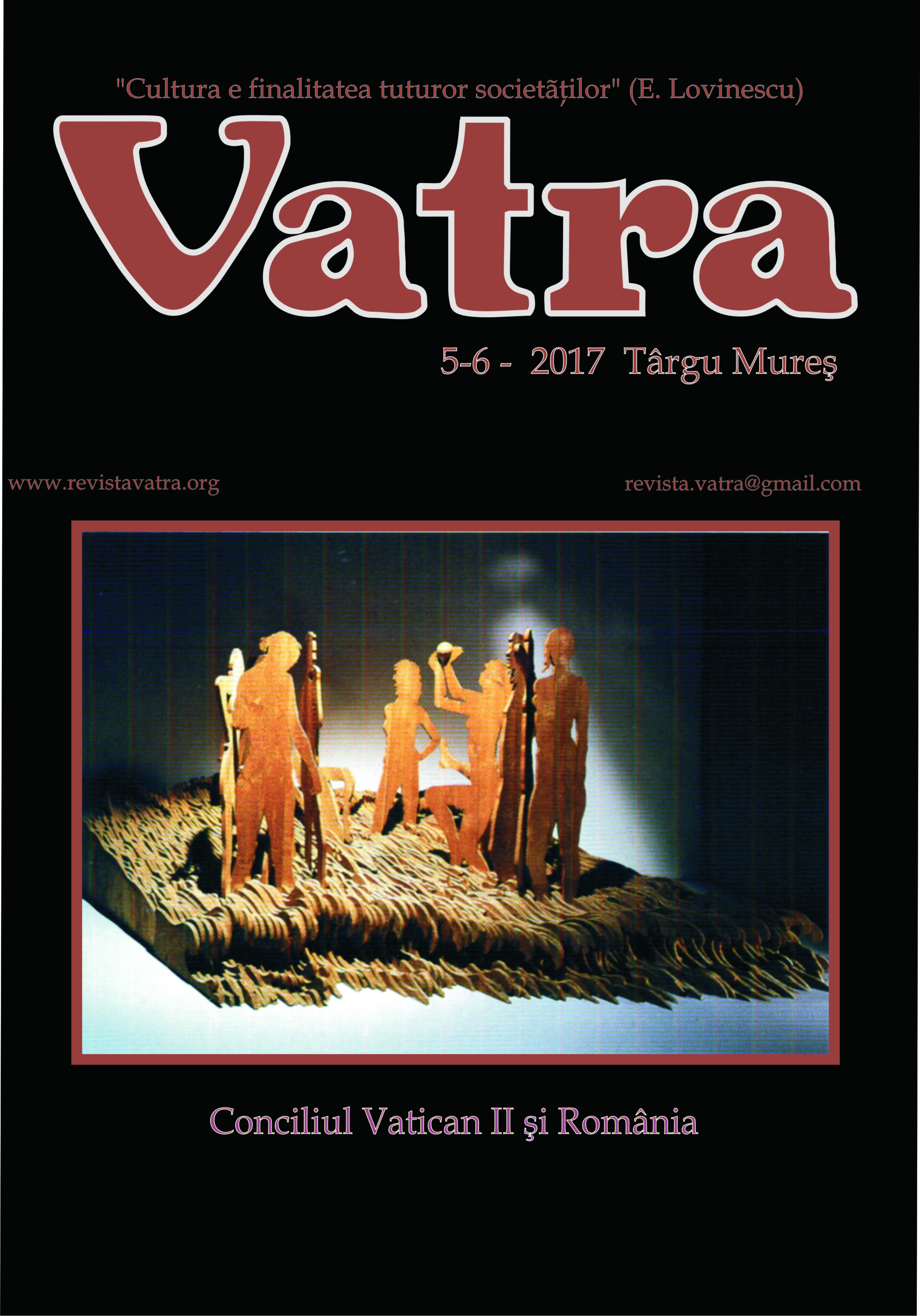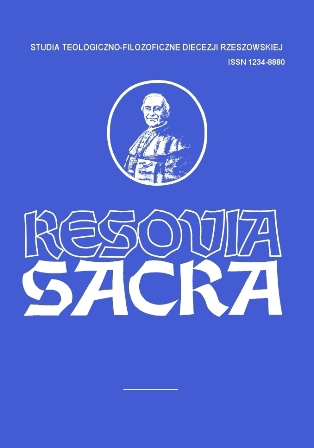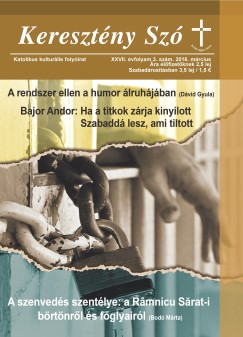
We kindly inform you that, as long as the subject affiliation of our 300.000+ articles is in progress, you might get unsufficient or no results on your third level or second level search. In this case, please broaden your search criteria.


This segment is a collection of essays about the history and the implications of the Second Vatican Council.
More...
Le but de cet article c'est de faire mieux connaître le frère Roger Schutz, fondateur de la Communauté Oecuménique à Teizé, assassiné le 16 août 2005 lors des prières du soir dans l’église de la Réconciliation. Au début sont présentées son origine franco-suisse, son enfance passée dans une famille nombreuse de pasteur calviniste, ses études théologiques. Ensuite sont décri- tes l'érection et le développement de la Communauté bâtie par Roger à Teizé, un village de Bourgogne en France, lieu devenu un centre de rencon- tres de la jeunesse chrétienne dont l’objet fut de réconcilier les différentes professions de la foi en Europe. Ensuite sont démontrées les relations entre la Communauté de frère Roger et l’Eglise Catholique. L’auteur a souligné en particulier les contacts de frère Roger avec les papes de son temps. Enfin, sont rapportées la mort et les obsèques de l’homme en habit blanc, qui a sacrifié sa vie afin que la réconciliation entre les chrétiens puisse voir le jour.
More...
After World War II the Catholic Church in Poland had to face hard tasks concerning the renewal of religious life in new socio-political conditions. The concept of the state introduced by communists could be achieved only by lessening the role and status of the Catholic Church in the society. The actions taken against the Roman-Catholic Church by the Security Apparatus were, in fact, restricted to observations of the clergy and checking suspicions of contacts with the underground resistance movement. However, the first repercussions struck the clergy in the Rzeszów area as early as between 1944 and 1947. They concerned mainly the priests actively involved in the fights for independence during the war, and connected with anticommunists after the war. Much earlier the repercussions were aimed at the Greek- Catholic Church. Imprisonment of bishops and priests, as well as the repat- riation of the majority of the faithful caused the decline of the Uniat Church. The fate of this Church was sealed with the ‘Wisła’ Operation, which result- ed in moving the clergy to the west and north of Poland, taking them to the Soviet Union and imprisoning at the Main Labour Camp in Jaworzno. During the next years the relations of the Church and the State were gradually declining as the result of moving away from the lawful norms.
More...
Hundred years passed in 2002 since Missionaries of the Saint Mary of La Salette arrived to Poland. During this time the Saletinians undertook in Poland many various priestly and formation acts resulting from their cha- risma, among others they kept a noviciate, in which they prepared candi- dates for monastic life for a year. The Saletinian noviciate was active in four localities: in Dębowiec near Jasło(1916-1917, 1924-1929, 1950-2003), in Hurko near Przemyśl (1929-1939), in Rzeszów (1947-1951) and Cracow (1969-1970, 1991-1992). Eighteen Saletinians fulfilled the function of the noviciate master, priest August Gauthier for the longest time. Master was usually assisted in the formation work by a noviciate sociate. Over five hun- dred and eighty candidates for monastic life passed through the Saletinian noviciate, out of which near four hundred and ninety became the professed monks for the first time.
More...









One of the many consequences of the baptism of Mieszko I was the entrance of our nation in the area of the christianitas culture. Henceforth, its boundaries in the history of Poland were determined through three very important factors: the cathedral, which generated the harmonious cooperation of secular and spiritual spheres; university, which led to the synthesis of faith and reason, and transformed the tradition of Roman law through the spirit of the Gospel; chivalric ethos, understood not as one’s skill with a sword but a code of conduct in the spirit of honor, loyalty and help provided to the weak.
More...
The aim of the study is to show, based on the few written sources and data from archaeological excavations, the beginnings of Christianityamong the Slavic tribes, inhabiting the land of Silesia. The adoption of the Christian religion of the Latin rite was problematic due to Silesia be- longing to the Czech Republic and the Vistulans State of Mieszko I. The development of Christianity took place with the creation of the Bishopric of Wrocław and its entry into the metropolis of Gniezno, established in 1000. Wrocław received a bishop, which was surrounded by a circle of clergy, the first Cathedral was erected in Ostrów Tumski, in various castles temples were built, which conducted ministry. It took a great evangelical effort to cause the Christianization of the whole of Silesia’s society.
More...
The baptism of Poland has constituted an important event from the dawn of history of the Polish nation, hence the remembrance of it was re- called both before the partition and during the national captivity. It had its special meaning during the second period, while the recollection cemented the nation which was torn by Russia, Austria and Prussia. Remembrance of Christianization of the Polish land was particularly maintained in Greater Poland. Landowners circles and the clergy initiated, literary, artistic and architectural undertakings, where the main motive was the Christianiza- tion of Poland. The Golden Chapel in the Cathedral in Poznań, which has meant to be as necropolis for Mieszko I and Bolesław Chrobry, became the crucial sign of it. However, not to mention jubilees commemorating the Christianization organised from 1860 until 1863 and in 1916. All those initiatives were developing the Polish spirit and kept strenghtening catholic identity of Poles exposed to Germanization.
More...
The Millennium of Christianity in Poland in 1966 was also celebrated beyond its borders. The role of Coordinator and participant in these cele- brations in different countries of the world was given to a delegate of the Polish Primate Cardinal Stefan Wyszynski for the pastoral care in exile, Bishop Wladyslaw Rubin (1917-1990), who later became cardinal (1979) and Prefect of the Congregation for Eastern Churches (1980-1985). He also represented the Polish Primate in the millennial celebrations abroad, in which the Primate could not participate in himself due to political rea- sons. World Millennium celebrations abroad were opened by Pope Paul VI on the 13th of January 1966 in Rome. There he also held their central celebrations (12-15 May 1966). Bishop Rubin participated in the millennial celebrations in England (London, 6 February 1966), Canada (Toronto, 30, IX and X 1, Montreal, 5 X), United States (9 VIII-X 19), Sweden (Novem- ber 4-11), etc. They concluded the Marian shrine of Loreto (December 20, 1966). In his sermon, Bishop Rubin then said: „The Church has seen in the religious celebrations of the millennium, an important factor in the spiri- tual revival of the believers and strengthening the faith in the nation. This was the aim of the celebrations of the Millennium of Polish Christianity, so that the social unity of the nation was cemented in faith an love, as it was for ten centuries in the nation.” The Bishop Rubin helped to organize the exhibition „Aftermath of the Millenium” (1966-1967) at the Church of St. Stanislaus in Rome and release the album Millennium Poloniae Christi- anae (Rome, 1966). In recognition for his commitment in organizing and conducting the millennium celebrations abroad the Canadian Polish Con- gress awarded him with the „Millennium of Polish Christianity” medal.
More...
The subject of this article’s inquiry is the origin of Polish primacy, which is bound up with the office of the Archbishop of Gniezno. The lack of a nomination document gave rise to several traditions. Generally speaking, the oldest sources provided three traditions: the beginnings of statehood and Christianization of Poland – X age (times of Prince Miec- zyslaw and King Boleslaw the Brave), half of the fourteenth century (the rule of King Casimir the Great) and the Council of Constance (1414-1418). These traditions influenced the development of historical writing. The second theme of interest which is reflected by literature, was the nature of the office of the primate, i.e. whether he was appointed by the ruler or the church (council, the Pope). At the current stage of research it is widely accepted that the dignity of the Primate received Archbishop Nicholas Trąba during the Council of Constance, but closer circumstances are still not explained.
More...